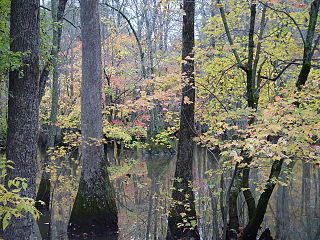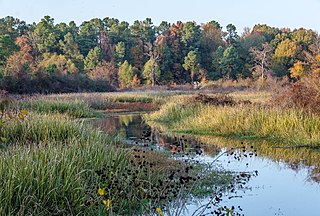Related Research Articles
Jesse M. Martin was best known as the acting governor of the U.S. state of Arkansas from January 11, 1909, to January 14, 1909. Senator Martin served as Acting Governor of Arkansas for three days until the inauguration of Governor George W. Donaghey.

Archibald Yell was an American politician and lawyer who served as the U.S. representative from Arkansas from 1836 to 1839, and 1845 to 1846. He was the second governor of Arkansas, serving from 1840 to 1844. Yell was killed in action at the Battle of Buena Vista on February 23, 1847.

Dandridge McRae was an American lawyer, court official, and Inspector General of Arkansas State Troops, as well as a brigadier general in the Confederate States Army during the American Civil War. He served in several key battles that helped secure Arkansas for the Confederacy, prolonging the war in the Western Theater.

The Ouachita River is a 605-mile-long (974 km) river that runs south and east through the U.S. states of Arkansas and Louisiana, joining the Tensas River to form the Black River near Jonesville, Louisiana. It is the 25th-longest river in the United States.

The Cache River National Wildlife Refuge is a 68,993 acre (223 km2) (2014) wildlife refuge in the state of Arkansas managed by the United States Fish and Wildlife Service (FWS). The refuge is one of the Ramsar wetlands of international importance under the Ramsar Convention signed in 1971. It is one of the most important wintering area for ducks and the largest remaining tract of contiguous bottomland hardwood forest on the North American continent. In 2005, a possible sighting of the ivory-billed woodpecker, thought to be extinct, brought attention to the refuge.

Big Lake National Wildlife Refuge is an 11,047-acre (45 km²) National Wildlife Refuge located in Mississippi County, Arkansas, managed by the United States Fish and Wildlife Service. It is situated 2 miles (3.2 km) east of Manila, Arkansas, and consists mostly of a shallow lake, swamp, and bottomland hardwood forests. The preservation of habitat for waterfowl in an intensely agricultural region is the primary purpose of the refuge. 6,400 acres (20 km²) of Big Lake is classified as a National Natural Landmark and 2,144 acres (8 km²) are classified as wilderness.

Lake Hamilton and Lake Catherine are a pair of man-made lakes around Hot Springs, Arkansas. The two lakes have greatly improved the tourism in Hot Springs. Both Lakes were created by Arkansas Power & Light.
Ingalls is an unincorporated community in Bradley County, Arkansas, United States, five miles south of Hermitage. Ingalls is situated at 161 feet above mean sea level. Genesee & Wyoming owns railroad that goes through Ingalls. The Fordyce & Princeton Railroad had purchased the railroad after the liquidation of Chicago, Rock Island and Pacific Railroad.

Bayou Bartholomew is the longest bayou in the world, meandering approximately 364 miles (586 km) between the U.S. states of Arkansas and Louisiana. It contains over 100 aquatic species making it the second most diverse stream in North America. Known for its excellent bream, catfish, and crappie fishing, portions of the bayou are considered some of the best kept secrets of Arkansas anglers. It starts northwest of the city of Pine Bluff, Arkansas, in the Hardin community, winds through parts of Jefferson, Lincoln, Desha, Drew, Chicot, and Ashley counties in Arkansas, and Morehouse Parish, Louisiana, and eventually dumps into the Ouachita River after passing by the northernmost tip of Ouachita Parish, near Sterlington, Louisiana. The bayou serves as the primary border separating the Arkansas Delta from the Arkansas Timberlands.
Corona is an unincorporated community in Tipton County, Tennessee, United States.

Cleveland is an unincorporated community in Conway County, Arkansas, United States. Cleveland is located on Arkansas Highway 95, 19 miles (31 km) north of Morrilton. Cleveland has a post office with ZIP code 72030. Cleveland was founded in 1890, named after former President Grover Cleveland.
The 60th United States Colored Infantry was a U.S.C.T. infantry regiment in the Union Army during the American Civil War. The regiment was composed of African American enlisted men commanded by white officers and was authorized by the Bureau of Colored Troops which was created by the United States War Department on May 22, 1863.

Slovak is an unincorporated community in Prairie County, Arkansas, United States. Slovak is located on Arkansas Highway 86 9.1 miles (14.6 km) south of Hazen. It is the only municipality in the United States named after the European country, Slovakia. The area was originally settled by Slovak immigrants and continues to celebrate its Slovak-American heritage.

The Kings River is a tributary of the White River. It rises in the Boston Mountains of Arkansas and flows northward for more than 90 miles into Table Rock Lake in Missouri. The Arkansas portion of the river is undammed and bordered by rural and forested land, the river is popular for paddling and sport fishing.

The Chicot County Courthouse is a courthouse in Lake Village, Arkansas, the county seat of Chicot County, built in 1956. Located at the end of the Lake Village Commercial Historic District along Lake Chicot, the courthouse is a culturally significant landmark for both its architectural style and historical importance to the county. It was because of this dual significance that the property was listed on the National Register of Historic Places in 2006.
Paul Kazuo Kuroda, was a Japanese-American chemist and nuclear scientist.
Baring Cross was a town in Pulaski County, Arkansas, United States, across the Arkansas River from Little Rock in the central part of the state.
The Battle of Mount Elba was a minor skirmish of the American Civil War, occurring on 30 March 1864 at the town of Mount Elba, Arkansas. It was part of U.S. General Steele's Camden Expedition.
References
- ↑ Wendy Richter, Arkansas History Commission: Flavius Josephus (Flave) Carpenter (1851–1933), http://www.encyclopediaofarkansas.net/encyclopedia/entry-detail.aspx?entryID=1204#, last updated 13 December 2007.
- ↑ "Carpenter Dam" photo at: http://www.encyclopediaofarkansas.net/encyclopedia/media-detail.aspx?mediaID=5942, undated (retrieved 17 Jun 2009).
- ↑ Richter, http://www.encyclopediaofarkansas.net/encyclopedia/entry-detail.aspx?entryID=1204#.
![]() This article incorporates public domain material from the Biographical Directory of the United States Congress website http://bioguide.congress.gov .
This article incorporates public domain material from the Biographical Directory of the United States Congress website http://bioguide.congress.gov .